Jacob Kramer: 'The Modigliani of the North'
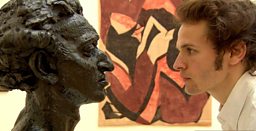
Jacob Kramer is a Jewish artist who migrated to Leeds to escape the Russian pogroms. Film maker Simon Glass has been discovering his work which has strong resonances for today’s Jews.
Jacob Kramer was one of Britain’s greatest artists in the 1920s and 1930s, renowned for his sharp, angular paintings influenced by Vorticism.
He was a friend of David Bomberg, Mark Gertler and Jacob Epstein but never wanted to join any artistic movement.
Kramer developed his own personal vision, drawing strongly on his Jewish roots. One art collector described him as ‘the Modigliani of the North'. Others compared him to Rembrandt and the Expressionists who were all influences on his work.
Kramer was a Jewish migrant who arrived in Britain aged 8 with his family in 1900. They were escaping from persecution and pogroms in Ukraine, then part of the Russian Empire.
For such a well-known artist, it may come as a surprise to discover that Kramer spent most of his artistic career working in Leeds rather than London.
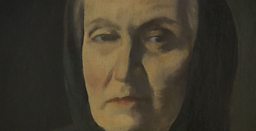
Simon Glass, a Leeds born film maker who now lives in London, was inspired by Kramer when he was growing up.
“Seeing Kramer’s works as a teenager persuaded me that his exploration of Jewish culture and history was something I should also take on as part of my identity and channel it through some of the work that I do.”
Kramer’s ‘hidden paintings’
Leeds Art Gallery is home to some of Kramer’s rarer works which aren’t currently on public display.
Simon Glass went behind the scenes at the gallery with curator, Nigel Webster, to look at a selection of these ‘hidden’ works in storage.
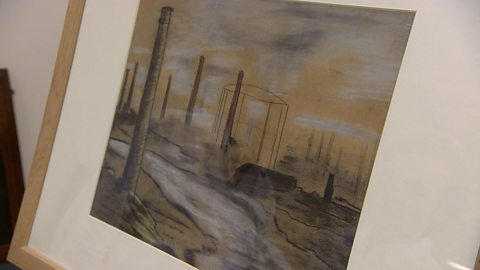
Video: The 'hidden' paintings of Jacob Kramer
Simon Glass discovers Jacob Kramer's 'hidden' paintings at Leeds Art Gallery
Many of his paintings feature scenes of Jewish persecution and suffering. They are based on real life stories told by his parents and neighbours who had migrated to Leeds from Russia.
One of his most famous early works, ‘Hear Our Voice, O Lord, our God’ (1919), shows the tortured face of a Jewish woman during a pogrom.
The colours are dark and moody with swirling blood reds and blacks, painted in a dramatic, twisted, expressionistic style. It’s a cry against Jewish persecution.
To make the painting more authentic, Kramer based the figure on his own mother who often modelled for him.
Jacob’s family were artistic – his father Max was a painter whilst his mother Cecilia had worked as a singer with an opera company.
When they lived in Ukraine, the Kramers had enjoyed the patronage of Baron Guenzburg, a member of a distinguished Russian-Jewish family of bankers and arts patrons.
But Britain was a foreign land. There were few rich patrons for immigrant Jews.
Max Kramer chose Leeds because a friend in the city had connections in the photographic business. He hoped to get a job doing something creative even if he couldn’t be an artist.
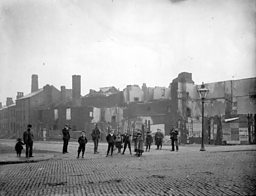
Coming to Leeds
The journey by ship was horrendous. The Kramers arrived in Hull, their port of entry, after a three-day boat trip before taking a the train a further 61 miles to Leeds.
Leeds around 1900 was described by one writer as “the ugliest and least attractive town in England” with coal, railways, engineering and tailoring at the heart of its economic success.
Herbert Read, the art critic and friend of Jacob Kramer, called it as “a wilderness of stone and brick, with soot falling like black snow”.
This may have inspired Kramer to draw ‘Industrial Landscape - Leeds’ with a gasometer and belching chimneys in 1914, a few years after his arrival in the city.
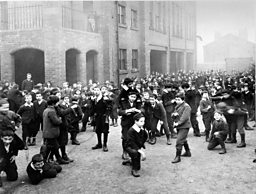
The Kramers lived briefly in The Leylands, a notorious slum and ghetto for new Jewish immigrants.
It was a far cry from their comfortable middle class existence in Ukraine. The back-to-back housing was overcrowded with a lack of sanitation, squalid conditions and disease.
Jacob went to Darley Street School in The Leylands which had a very high proportion of Jewish pupils.
His drawing and draughtmandship talents were encouraged there, thanks to a progressive headmaster, Harry Blackburn, and his art teacher, Gertrude Poyzer.
By the age of 12, Kramer had an exhibition of his own work on display at the school.
Later, Jacob was given a bursary and help from the Jewish Educational Aid fund to support his artistic education and endeavours.
With their backing, he won a scholarship to the Slade School of Art but he lasted only a short time before heading back to Leeds.
He continued his studies at the Leeds Arts School and went on to become a central figure in the Leeds Art Movement in the 1920s and 1930s.
The Leeds Arts Club was a hub for intellectuals, bohemians and artists who met and exchanged ideas, often in the surroundings of Whitelocks Ale House.
Jacob was a key member of the group and gradually gained critical acclaim not only in Yorkshire but in England where he put Leeds on the artistic map.
Jewish Identity
Jacob Kramer was extremely proud of being Jewish and was pre-occupied with the identity of the Jew.
But he was also an outsider – a Jewish migrant – trying to find his identity and gain recognition in his new homeland.
Leeds Art Gallery is home to some of Kramer’s greatest works where a new generation is discovering his distinctive expressionistic style.
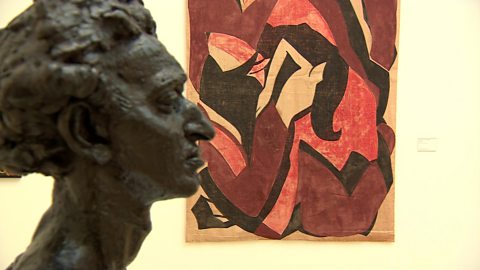
Jewish identity and Jacob Kramer's Day of Atonement
Jewish identity and Jacob Kramer's Day of Atonement
One of the works, ‘The Day of Atonement’, is considered to be Kramer’s masterpiece.
It represents a dramatic moment in a religious service on Yom Kippur, the holiest day of the Jewish calendar.
The painting with its stylised figures in prayer shawls took Kramer nine months to complete.
It displays strong Vorticist and Expressionists characteristics including bold angular lines, abstract figures and a subdued colour palette.
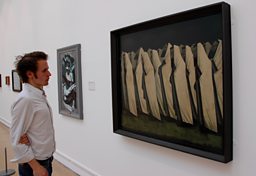
Simon Glass remembers how the painting made a big impression on him as a teenager growing up in Leeds:
“I remember first seeing it when I was about 15. Our school brought us to the gallery. Up until that point, being Jewish was very much something that I was hiding, especially going to a non-Jewish school. You wanted to fit in with everybody else.
“But coming here and seeing that, it was the first time I’d seen my own identity. Men in their shawls, the monochrome look that I associate with the synagogue and Judaism – being reflected for everybody in the city to see”.
Glass says that Kramer’s major achievement was the ability to capture the Jewish spirit and soul on canvas.
“When this was painted, Kramer himself would have been in Leeds 10 years or so. He himself was born in a foreign land. He was a wanderer. This impression of the lone wandering Jew for centuries has hovered over the Jewish identity.”

Video: Jacob Kramer's The Talmudists
Simon Glass discovers his Jewish roots in The Talmudists.
The painting shares similar stylistic qualities to ‘The Day of Atonement’ with its geometric figures, simplified forms and stark, contrasting colours.
Simon Glass says it reminds him of the Jewish community during his grandfather’s time:
“The Jewish elders are learning from a book, the Torah. They look very familiar, just like my grandfather’s generation in Leeds. They remind me of the men he would learn with in the synagogue when I was a young boy”.
Kramer’s painting was also inspired by scenes he remembered when he lived in the Jewish quarter of London’s East End.
Kramer’s Inspiration in Leeds
Jacob Epstein was a close friend of Kramer and in 1921 he modelled a bust of the Leeds artist which is considered to be one of his finest works.
Epstein described Kramer as “a model who seemed to be on fire. He was extraordinarily nervous. Energy seemed to leap into his hair as he sat, and sometimes he would be shaken by queer trembling.”
Kramer was never to reach quite the heights that Epstein achieved during his career. But he was a visionary whose work transcended boundaries and broke conventions.
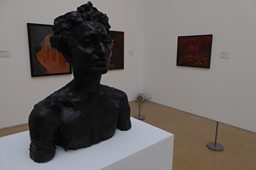
Today, 100 years after the creation of ‘The Day of Atonement’, Kramer’s work is enjoying a renaissance as a new generation discovers his art and its strong sense of Jewish identity.
Leeds was where he chose to work and live, and Kramer noted that “For myself, I find more stimulus in Leeds than in London and even in Paris”.
Later in his career, he painted portraits of the rich and famous including Gandhi, Delius, Sybil Thorndike and Anna Pavlova.
But it was in Leeds that he discovered the depths of his Jewish soul and conveyed that identity so distinctively on canvas.
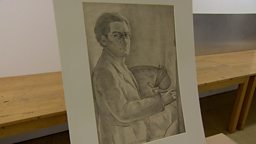
About the programme
Film maker Simon Glass explores the ‘lost world’ of the Jews in Yorkshire in the early 20th Century.
Hundreds of thousands of Jewish migrants and refugees travelled from the Baltic states of Russia to British ports between 1880-1920.
Many were fleeing poverty and persecution; some worked and settled in Leeds, where they lived in a notorious run-down area known as the Leylands.
Jacob Kramer's family were one of those families, fleeing from Ukraine where there had been pogroms.
Discover more about Jacob Kramer's journey in ‘A Very British History – The Jews of Leeds’ on ���˿��� Four at 21:00 on 25 February 2019.
Related Links
Acknowlegements
Thanks to the William Roberts Society and Leeds Art Gallery for their permission to film Jacob Kramer's works.
